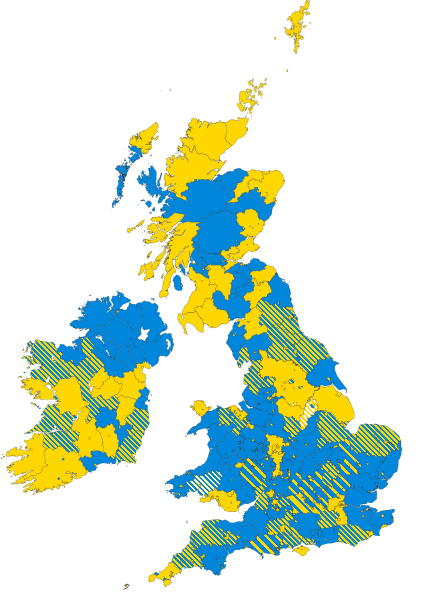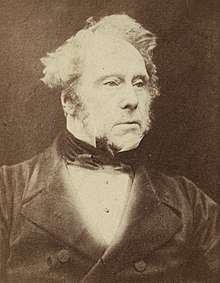1859 United Kingdom general election
In the 1859 United Kingdom general election, the minority Conservative government of Earl of Derby failed to achieve a majority of seats in the House of Commons. Despite making overall gains, Derby's government was defeated in a confidence vote by an alliance of the Whigs, led by Lord Palmerston and other political groupings including the Peelites, Radicals and the Irish Brigade. Palmerston subsequently formed a new government from this alliance which is now considered to be the first official Liberal Party administration.
| ||||||||||||||||||||||||||||||||||
All 654 seats in the House of Commons 328 seats needed for a majority | ||||||||||||||||||||||||||||||||||
|---|---|---|---|---|---|---|---|---|---|---|---|---|---|---|---|---|---|---|---|---|---|---|---|---|---|---|---|---|---|---|---|---|---|---|
| ||||||||||||||||||||||||||||||||||
 Colours denote the winning party—as shown in § Results | ||||||||||||||||||||||||||||||||||
| ||||||||||||||||||||||||||||||||||
There is no separate tally of votes or seats for the Peelites. They did not contest elections as an organised party but more as independent Free trade Conservatives with varying degrees of distance from the two main parties.
It was also the last general election entered by the Chartists, before their organisation was dissolved. As of 2020, this is the last election in which the Conservatives won the most seats in Wales,[1] as well as being the last election to date in which the Conservative Party took less than a third of the vote in England.
The election was the quietest and least competitive between 1832 and 1885, with most county elections being uncontested. The election also saw the lowest number of candidates between 1832 and 1885, with Tory gains potentially being the result of a lack of opposition as much as a change in public opinion.[2] According to A.J.P. Taylor:
- the government which Palmerston organized in June 1859 was a coalition of a different kind : not a coalition of groups which looked back to the past, but a coalition which anticipated the future. Had it not been for Palmerston himself^too individual, too full of personality to be fitted into a party-pattem—it would have been the first Liberal government in our history. Everything that was important in it was Liberal—finance, administrative reform, its very composition : the first government with unmistakable middle-class Free Traders as members.[3]
|
|
Results
| UK general election 1859 | |||||||||||||||
|---|---|---|---|---|---|---|---|---|---|---|---|---|---|---|---|
| Party | Candidates | Votes | |||||||||||||
| Stood | Elected | Gained | Unseated | Net | % of total | % | No. | Net % | |||||||
| Liberal | 465 | 356 | −21 | 54.43 | 65.80 | 372,117 | −0.2 | ||||||||
| Conservative | 394 | 298 | +34 | 45.57 | 34.17 | 193,232 | +0.3 | ||||||||
| Chartist | 1 | 0 | 0 | 0 | 0 | 0 | 0.03 | 151 | −0.1 | ||||||
Regional results
Great Britain
| Party | Candidates | Unopposed | Seats | Seats change | Votes | % | % change | |
|---|---|---|---|---|---|---|---|---|
| Liberal | 392 | 157 | 306 | 314,708 | 66.6 | |||
| Conservative & Peelites | 327 | 160 | 245 | 157,974 | 33.4 | |||
| Chartist | 1 | 0 | 0 | 151 | 0.0 | |||
| Total | 720 | 317 | 551 | 472,833 | 100 | |||
England
| Party | Candidates | Unopposed | Seats | Seats change | Votes | % | % change | |
|---|---|---|---|---|---|---|---|---|
| Liberal | 330 | 109 | 251 | 307,949 | 67.1 | |||
| Conservative & Peelite | 286 | 129 | 209 | 152,591 | 32.9 | |||
| Chartist | 1 | 0 | 0 | 151 | 0.0 | |||
| Total | 617 | 238 | 460 | 460,691 | 100 | |||
Scotland
| Party | Candidates | Unopposed | Seats | Seats change | Votes | % | % change | |
|---|---|---|---|---|---|---|---|---|
| Liberal | 44 | 34 | 40 | 5,174 | 66.4 | |||
| Conservative & Peelite | 17 | 11 | 13 | 2,616 | 33.6 | |||
| Total | 61 | 45 | 53 | 7,790 | 100 | |||
Wales
| Party | Candidates | Unopposed | Seats | Seats change | Votes | % | % change | |
|---|---|---|---|---|---|---|---|---|
| Conservative & Peelite | 18 | 14 | 17 | 2,767 | 63.6 | |||
| Liberal | 18 | 14 | 15 | 1,585 | 36.4 | |||
| Total | 36 | 28 | 32 | 4,352 | 100 | |||
Ireland
| Party | Candidates | Unopposed | Seats | Seats change | Votes | % | % change | |
|---|---|---|---|---|---|---|---|---|
| Irish Conservative & Peelite | 67 | 36 | 53 | 35,258 | 38.9 | |||
| Liberal | 73 | 26 | 50 | 57,409 | 61.1 | |||
| Total | 140 | 62 | 103 | 92,667 | 100 | |||
Universities
| Party | Candidates | Unopposed | Seats | Seats change | Votes | % | % change | |
|---|---|---|---|---|---|---|---|---|
| Conservative & Peelite | 6 | 6 | 6 | |||||
| Total | 6 | 6 | 6 | 100 | ||||
References
- Scully, Roger, "Why Wales decided to forgive the Tories", spectator.co.uk, retrieved 4 May 2017
- Hawkins, A. (18 June 1987), Parliament, Party and the Art of Politics in Britain, 1855–59, p. 377, ISBN 9781349089253
- A. J. P. Taylor, "Lord Palmerston," History Today (1951) 1#7 pp 35-41 at p. 39 online
Sources
- Craig, F. W. S. (1989), British Electoral Facts: 1832–1987, Dartmouth: Gower, ISBN 0900178302
- Rallings, Colin; Thrasher, Michael, eds. (2000), British Electoral Facts 1832–1999, Ashgate Publishing Ltd

.jpg)